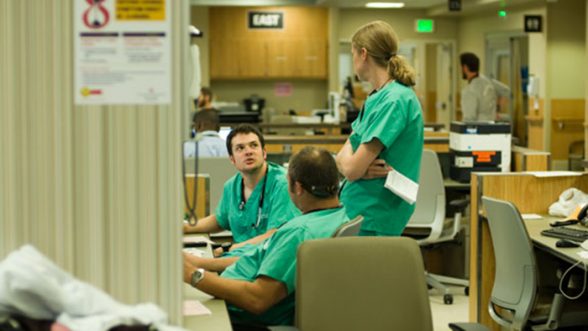
Business School students develop system to test expanded hospital ER, draw interest from global health care organization
DENVER and AURORA, Colo.—CU Denver Business School students Allyson Robbins and Michelle Boyd knew they had a powerful tool in a software program that analyzes workplace operations.
Then, through a spring 2013 Business Analytics capstone project, they used the software to test a real-world workflow—innovative redesigns in an expanded hospital emergency room. The collaboration proved successful and opened Robbins and Boyd’s eyes to the need for similar simulations in the health care industry.
Now they’ve launched their own business, Analytical Decision Services, LLC, (ADS) and are lining up clients interested in the kind of service they provided to the University of Colorado Hospital’s newly expanded Emergency Department.
Mentorship from capstone professor helped guide business students
Pointing Robbins and Boyd, who have complementary skills and had teamed on previous classroom projects, in the direction of UCH’s Emergency Department was their capstone professor, Gary Kochenberger, Ph.D. His mentorship changed the course of Robbins and Boyd’s careers.
“He has supported us every step of the way and we still meet with him regularly,” Robbins said. “He continues to provide insight and present potential opportunities to us.”
On the horizon is another opportunity: Robbins and Boyd will enter ADS in the Jake Jabs Center for Entrepreneurship Business Plan Competition this summer.
In 2005, Robbins graduated from the Skaggs School of Pharmacy and Pharmaceutical Sciences with a Doctor of Pharmacy degree. She augmented her extensive health care background with an interest in process improvement and analytics that led her to completing an MS Decision Sciences (beginning Fall 2014 renamed Business Analytics) degree from the CU Denver Business School.
Boyd, meanwhile, has more than 15 years of experience in information technology and data analysis. She is a disabled veteran, having served in the U.S. Army from 1992 to 1998 as a missile operator and system administrator. Boyd earned a BS in accounting from CU Denver in 2005 and is currently pursuing a dual MS degree in Information Systems/Business Analytics.
Kochenberger said that all the students in the capstone class—Ken Walsh and Gray Frain joined Robbins and Boyd on a team—were outstanding, but noted that Robbins and Boyd had a “strong bond” from previous projects. “It led them to think about ways to leverage what they learned in the course to add value in other health care organizations,” he said.
Modeling simulation becoming a useful tool in health care
The hospital’s ED redesign, which opened in spring 2013 after being under development for several years, presented an opportunity to apply the software. Simio, a highly dynamic simulation modeling system, develops 3-dimensional models of workspaces that accurately reflect complex interactions between customers, or patients, with resources and staff. The Business Analytics Department received a $58,000 grant from Simio to use the state-of-the-art software.
“They’ve been very good to us,” Kochenberger said of Simio. “And they’ve helped Allyson and Michelle publicize their business.”
Modeling simulation for process improvement has been used extensively in other industries, especially manufacturing, but is now employed in a wider spectrum, including health care.
In the case of the UCH ED, “they knew they were going to have increases in the numbers of patients coming through (the expansion doubled the size of the facility), and they had to come up with innovative ways to help move patients through more quickly. They wanted to see if these new features performed as they were intended,” Robbins said. “That was the goal of the model we developed—to really test the system out and see if it was going to function as they thought.”
Also, the software is a showcase tool that allows the UCH ED to demonstrate the department’s new features and how patients flow through it.
“They’ve had various health care organizations from across the world come in and look at their Emergency Department, and they’ve been able to demonstrate it without a whole walkthrough,” Boyd said. “In 3-D, people can see all the moving pieces.”
UCH purchased and upgraded the software and plans to use it in other areas of the hospital. Boyd said ADS is now working with Mental Health Center of Denver on process improvements because the center is expecting an influx of patients due to the Affordable Care Act.
‘It will enhance process improvement strategies’
“We’re working with them to identify areas that will be affected and how they can prepare for that influx,” Boyd said. “We want to target health care and organizations that have process improvement teams in place because we think it will enhance their process improvement strategies.”
Derek Birznieks and Justin Emerick work in the Process Improvement department at UCH. Emerick, process improvement consultant, said the Simio software offered “amazing” adaptability. “Just as fast as you can put new data into the model it will spit out results for you,” he said. “It’s real versatile in that way.”
Versatility is what they needed, considering the hospital’s ED had completely changed its delivery care model. Birznieks, system director, said collaborating with the Business School capstone class, where students apply classroom information to real-world problems, offered mutual benefits. “It was great for us because it didn’t cost us anything to use the software on testing,” he said. “I think the Business School students got a lot out of it as well. It was practical experience for them.”
Birznieks said UCH will continue to collaborate with Kochenberger’s Business Analytics class on modeling other areas of the hospital.
Kochenberger said ADS’s opportunities are only going to grow, thanks to the national movement to improve health care operations. “It’s really great when educational experiences combine with entrepreneurial drive to create new businesses,” he said. “I’ve really enjoyed watching this happen.”
From their new office in Aurora, Boyd and Robbins realize that their timing couldn’t be better.
“Health care organizations that are jumping on board are leading the way by being very innovative and trying to break ground,” Robbins said.


